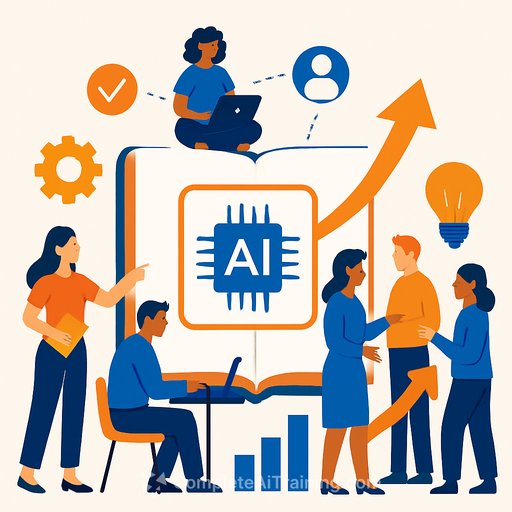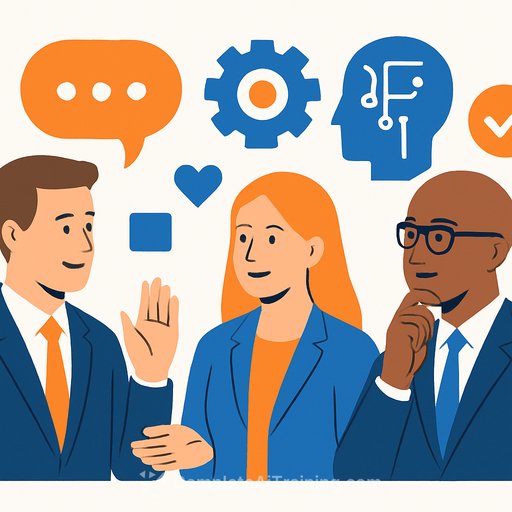HR Leaders: Upskill And Reskill With AI
AI is here, and it's changing how every function works. For HR, the job is two-fold: modernize the tools inside the people function and build the skills that help every team use AI responsibly and effectively. That takes clear strategy, practical execution and real empathy for employees who are being asked to work in new ways.
The payoff is worth it. AI can shift HR from reactive administration to proactive talent strategy with better workforce planning, sharper hiring and targeted development. Below is a field-tested plan you can put to work now.
6 Steps To Successful Upskilling And Reskilling
1) Map roles
Decide where AI will have the most impact: automating repetitive tasks, augmenting current roles or enabling new ones. Treat this as a role redesign exercise, not just a tool rollout. Skills-based hiring should guide your approach-teams report stronger results when hiring by skills instead of degrees.
2) Assess the skills gap
Establish a baseline. Use short surveys, manager input and work samples to capture current capability. Then apply analytics to compare today's skills with future needs and flag gaps by role, level and location.
3) Build a clear skills taxonomy
Create a concise, shared list of priority skills across technical, process and human strengths. Pull from internal job data, leading job postings and employee interviews. For structure and examples, see guidance from McKinsey & Company.
4) Create personalized learning paths
Match learning to the skills each role needs. For smaller teams, leverage platforms like Coursera, Udemy and LinkedIn Learning. For larger teams, partner with universities and industry trainers, and add microlearning, webinars and hands-on labs to boost completion and retention.
If you want curated options by role, explore job-based AI paths here: Complete AI Training: Courses by Job.
5) Build a culture of continuous learning
Make development part of how work gets done. Tie learning to company values, manager goals and performance check-ins. Recognize progress publicly, and set aside time each month for skill sprints.
6) Measure and improve
- Learning: enrollments, completions, skill assessments
- Adoption: tool usage by team and role
- Impact: time saved, quality metrics, error rates, customer outcomes
- Talent: internal mobility, time-to-fill, retention of critical roles
Review quarterly with business leaders. Keep what works, refine what doesn't and retire what stalls.
Challenges And How To Handle Them
Change creates uncertainty. Some employees will worry about job loss or feel exposed by skill gaps. Counter that with clarity on how roles will evolve, fair access to learning and a supportive manager experience.
Prioritize ethics, integrity and empathy in how AI is selected and implemented. Pair technical training with human skills: problem framing, critical thinking, collaboration and judgment.
Incentivize adoption with simple, visible moves:
- Company-wide AI goals with progress updates and team shout-outs
- A learning club or cohort model that makes practice social and consistent
- Financial rewards for skill milestones tied to business outcomes
What Smaller Companies Should Do Differently
SMEs often lack big budgets and in-house experts, but they move faster. Start with cloud tools, pilot in one team, and scale what proves value. Short decision cycles and tight teams make change smoother if leaders are clear and hands-on.
Keep the stack simple, pick measurable use cases and upskill the people who touch those workflows first. Aim for weeks, not months, from idea to pilot to rollout.
Two Paths: Displace Or Develop
Skipping reskilling can lead to job loss in areas heavy on repetitive tasks. A better path: keep your people and expand their skills. One large retailer used an AI agent to handle 47% of customer inquiries and then reskilled 8,500 service reps into interior design advisors-unlocking new revenue while retaining experience and culture.
Quick Start Plan For HR
- Week 1: Pick three AI use cases with clear metrics. Define success and guardrails.
- Week 2: Launch a skills survey and manager calibration for impacted roles.
- Week 3: Publish a v1 skills taxonomy and assign learning pathways.
- Week 4: Kick off a 30-day learning sprint with weekly check-ins and a simple scorecard.
Looking Ahead
AI's impact on HR is significant, but the outcome is up to how you plan and execute. Put upskilling and reskilling at the center of your roadmap, measure what matters and lead with empathy. Teams that learn fast will outpace teams that hesitate.
Your membership also unlocks:






